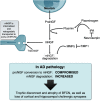The Brain NGF Metabolic Pathway in Health and in Alzheimer's Pathology
- PMID: 30809111
- PMCID: PMC6379336
- DOI: 10.3389/fnins.2019.00062
The Brain NGF Metabolic Pathway in Health and in Alzheimer's Pathology
Abstract
Emerging research has re-emphasized the role of the cortical cholinergic system in the symptomology and progression of Alzheimer's disease (AD). Basal forebrain (BF) cholinergic nuclei depend on target-derived NGF for survival during development and for the maintenance of a classical cholinergic phenotype during adulthood. In AD, BF cholinergic neurons lose their cholinergic phenotype and function, suggesting an impairment in NGF-mediated trophic support. We propose that alterations to the enzymatic pathway that controls the maturation of proNGF to mature NGF and the latter's ulterior degradation underlie this pathological process. Indeed, the NGF metabolic pathway has been demonstrated to be impaired in AD and other amyloid pathologies, and pharmacological manipulation of NGF metabolism has consequences in vivo for both levels of proNGF/NGF and the phenotype of BF cholinergic neurons. The NGF pathway may also have potential as a biomarker of cognitive decline in AD, as its changes can predict future cognitive decline in patients with Down syndrome as they develop preclinical Alzheimer's pathology. New evidence suggests that the cholinergic system, and by extension NGF, may have a greater role in the progression of AD than previously realized, as changes to the BF precede and predict changes to the entorhinal cortex, as anticholinergic drugs increase odds of developing AD, and as the use of donepezil can reduce rates of hippocampal and cortical thinning. These findings suggest that new, more sophisticated cholinergic therapies should be capable of preserving the basal forebrain thus having profound positive effects as treatments for AD.
Keywords: Alzheimer’s disease; basal forebrain cholinergic nuclei; cholinergic system; nerve growth factor; trophic support.
Figures
Similar articles
-
The NGF Metabolic Pathway: New Opportunities for Biomarker Research and Drug Target Discovery : NGF Pathway Biomarkers and Drug Targets.Adv Exp Med Biol. 2021;1331:31-48. doi: 10.1007/978-3-030-74046-7_4. Adv Exp Med Biol. 2021. PMID: 34453291
-
The Nerve Growth Factor Metabolic Pathway Dysregulation as Cause of Alzheimer's Cholinergic Atrophy.Cells. 2021 Dec 22;11(1):16. doi: 10.3390/cells11010016. Cells. 2021. PMID: 35011577 Free PMC article. Review.
-
Nerve Growth Factor Compromise in Down Syndrome.Front Aging Neurosci. 2021 Aug 9;13:719507. doi: 10.3389/fnagi.2021.719507. eCollection 2021. Front Aging Neurosci. 2021. PMID: 34434101 Free PMC article. Review.
-
The human brain NGF metabolic pathway is impaired in the pre-clinical and clinical continuum of Alzheimers disease.Mol Psychiatry. 2021 Oct;26(10):6023-6037. doi: 10.1038/s41380-020-0797-2. Epub 2020 Jun 2. Mol Psychiatry. 2021. PMID: 32488129 Free PMC article.
-
NGF-cholinergic dependency in brain aging, MCI and Alzheimer's disease.Curr Alzheimer Res. 2007 Sep;4(4):351-8. doi: 10.2174/156720507781788774. Curr Alzheimer Res. 2007. PMID: 17908036 Review.
Cited by
-
Postsynaptic structure formation of human iPS cell-derived neurons takes longer than presynaptic formation during neural differentiation in vitro.Mol Brain. 2021 Oct 11;14(1):149. doi: 10.1186/s13041-021-00851-1. Mol Brain. 2021. PMID: 34629097 Free PMC article.
-
Ultrasound delivery of a TrkA agonist confers neuroprotection to Alzheimer-associated pathologies.Brain. 2022 Aug 27;145(8):2806-2822. doi: 10.1093/brain/awab460. Brain. 2022. PMID: 34919633 Free PMC article.
-
Ted Sourkes, Moussa Youdim and I.J Neural Transm (Vienna). 2020 Feb;127(2):119-123. doi: 10.1007/s00702-019-02135-4. Epub 2020 Jan 18. J Neural Transm (Vienna). 2020. PMID: 31953605 No abstract available.
-
The NGF Metabolic Pathway: New Opportunities for Biomarker Research and Drug Target Discovery : NGF Pathway Biomarkers and Drug Targets.Adv Exp Med Biol. 2021;1331:31-48. doi: 10.1007/978-3-030-74046-7_4. Adv Exp Med Biol. 2021. PMID: 34453291
-
Peptides Derived from Growth Factors to Treat Alzheimer's Disease.Int J Mol Sci. 2021 Jun 4;22(11):6071. doi: 10.3390/ijms22116071. Int J Mol Sci. 2021. PMID: 34199883 Free PMC article. Review.
References
Publication types
Grants and funding
LinkOut - more resources
Full Text Sources
Other Literature Sources
Miscellaneous


